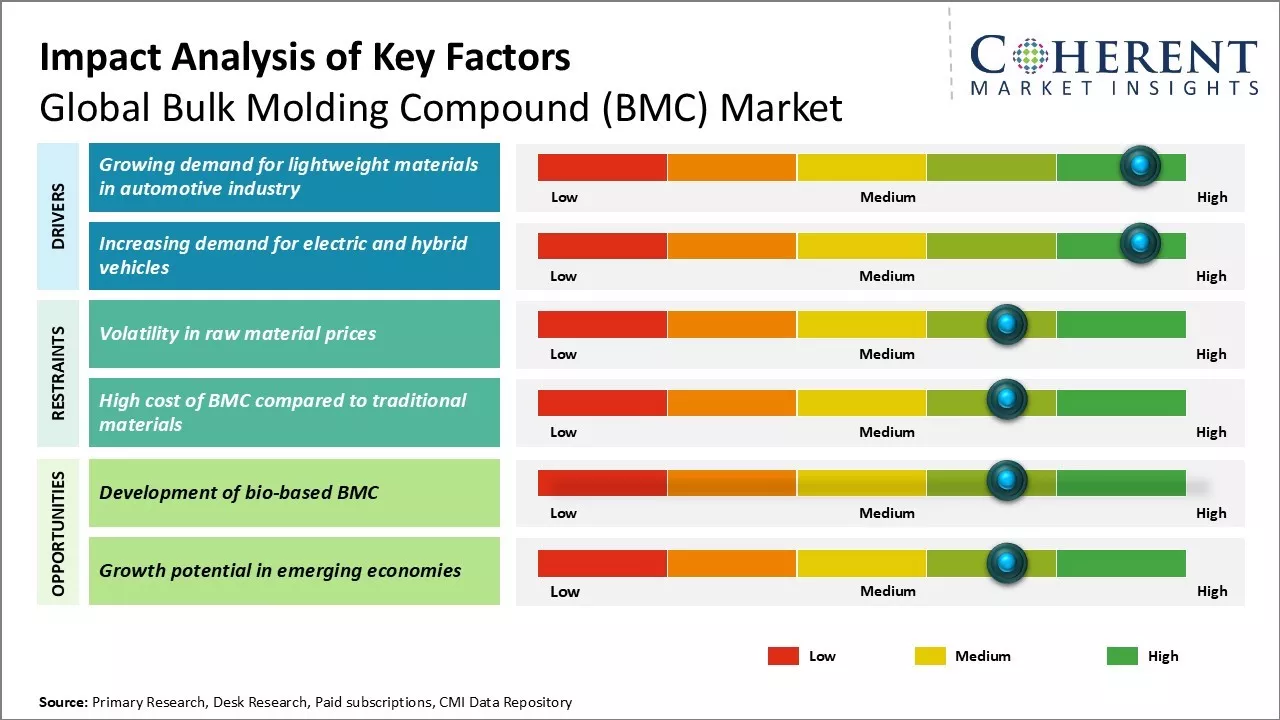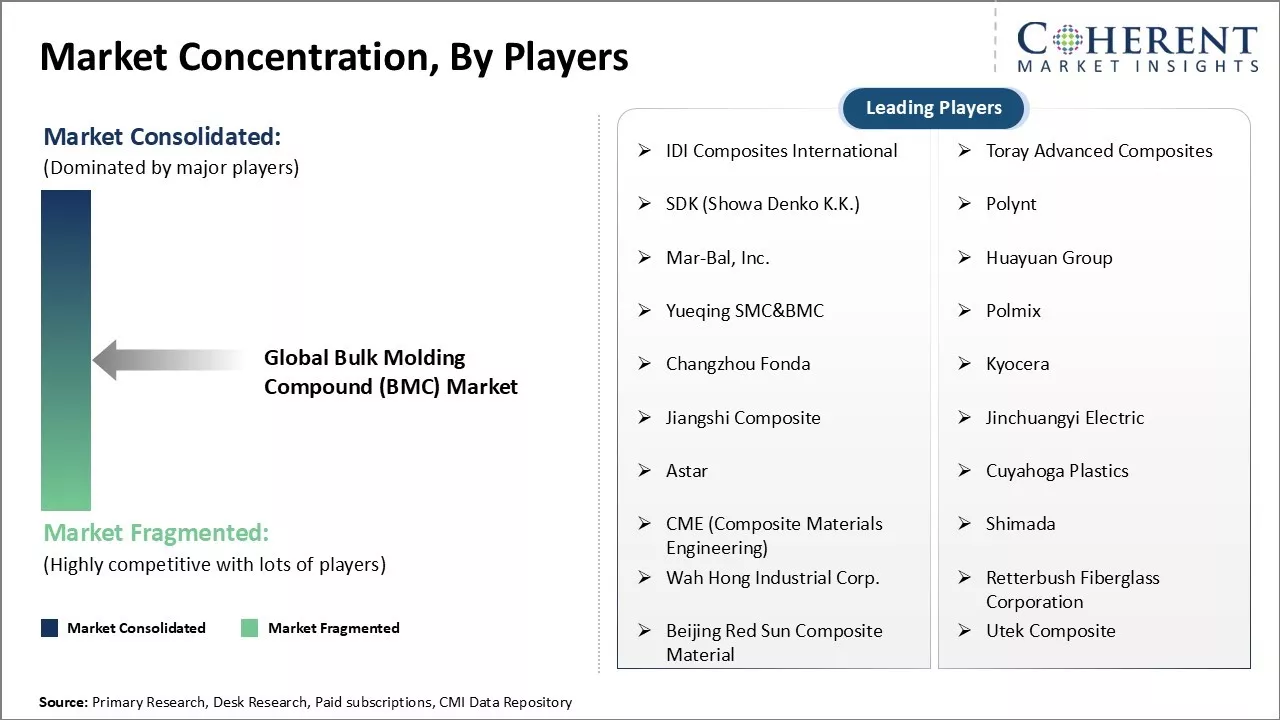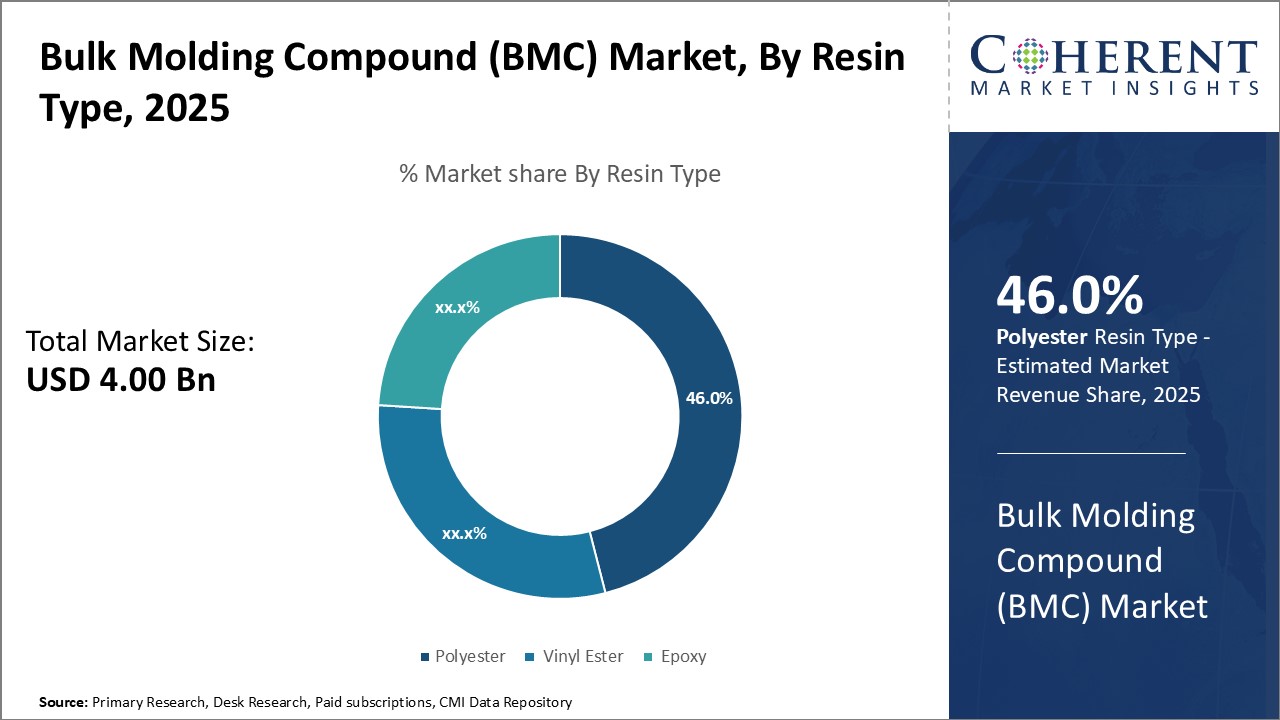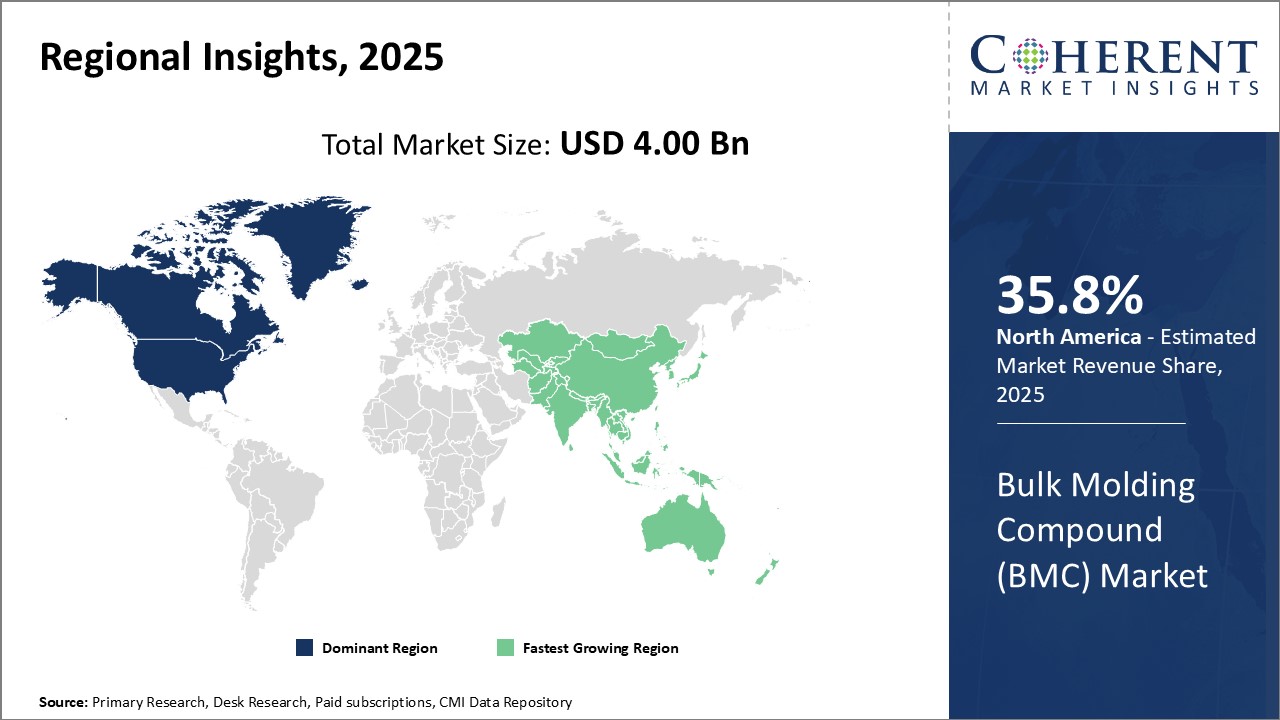Bulk Molding Compound (BMC) Market Size and Trends
The global bulk molding compound (BMC) market is estimated to be valued at USD 4.00 Bn in 2025 and is expected to reach USD 5.52 Bn by 2032, exhibiting a compound annual growth rate (CAGR) of 4.7% from 2025 to 2032.

Discover market dynamics shaping the industry: Download Free Sample
Bulk molding compounds find widespread application in industrial equipment and automotive components owing to properties such as chemical and heat resistance. Major players are investing in R&D to develop bio-based BMC resins in order to cater to the increasing demand for sustainable construction materials. Market leaders are focusing on strategic acquisitions and partnerships to gain a bigger share of global bulk molding compound (BMC) market. The future looks positive as the market is expected to grow steadily driven by increasing automotive production and a rebound in industrial activity worldwide post pandemic.
Market Driver - Growing demand for lightweight materials in automotive industry
The automotive industry has been focusing on developing lightweight vehicles in order to improve fuel efficiency and reduce carbon emissions from vehicles. Bulk molding compounds provide an excellent solution for automakers to reduce vehicle weight as BMC helps in substituting heavier conventional materials. BMC offers 10-30% weight savings compared to traditional die-cast metals and 15-40% savings over glass-filled nylon. The material is increasingly being used in under-the-hood components like intake manifolds, valve covers, and various housings. It is also finding applications in exterior auto parts like bumpers, grilles, and panels.
With stricter emission standards being imposed, vehicle manufacturers are under pressure to cut down weight significantly without compromising structural strength. This is driving collaboration between OEMs and material developers to optimize design and engineering of lightweight components. BMC delivers strength and rigidity comparable to metals while bringing about substantial mass reduction. Its press molding process also allows for complex shapes and integrated features, eliminating joints and bolts. All these attributes have fueled a rise in BMC adoption among top carmakers worldwide.
Regulations on fuel economy and greenhouse gas emissions are getting more stringent with each new phase. To meet these criteria, automakers are increasingly turning to mixed material strategies and advanced composites like BMC. The material is proving its mettle in high-volume commercial vehicles as well where payload requirements as well as operating costs are major deciding factors. As the industry accelerates its transition to electric powertrains, reducing vehicle curb weight becomes even more pivotal to improving driving range per charge. This will further spur innovations with lightweight press molded polymer matrix composites. Overall, the rising need for structural weight savings is expected to present a compelling argument for greater BMC utilization across different automotive segments in the coming years.
Market Concentration and Competitive Landscape

Get actionable strategies to beat competition: Download Free Sample
Increasing demand for electric and hybrid vehicles
Increasing demand for electric and hybrid vehicles is significantly driving the growth of the global bulk molding compound (BMC) market. Electric vehicles require complex circuitry and efficient battery modules to store and discharge electricity efficiently. BMC provides properties like strength, rigidity and thermal resistance that are ideal for housing such intricate precision components. As BMC can be easily molded into complex shapes needed for compact packaging, it is increasingly being used by automakers to manufacture casings and housings for electric vehicle batteries, electric motors, chargers and other electrical control units.
There is a growing momentum towards sustainable clean energy driven transportation globally. Many countries have outlined targets and timelines to shift a significant portion of their vehicle fleet to electric. For instance, countries like China, USA, UK, France and Germany have set goals for electric vehicle sales targets between 30-50% of total vehicles sold by 2030. This policy push is translating to huge investments by automakers in developing electric models. According to the International Energy Agency, electric car stock globally increased by 43% to 10 million in 2021 alone. Their projections estimate electric car sales could rise to over 145 million by 2030. The growing electric vehicle fleet will undoubtedly fuel greater demand for advanced materials like BMC from the automotive industry in coming years.
Key Takeaways from Analyst:
global bulk molding compound (BMC) market is projected to experience moderate growth in the coming years. The automotive industry will continue to be a major driving force leading demand for BMC as OEMs aim to produce lighter vehicles and reduce fuel consumption. In particular, Asian countries like China and India which are among the largest automotive producers globally will bolster BMC consumption. Increased usage of composite materials in automotive as a substitute for metals offers opportunities for BMC vendors. Additionally, the electronics industry utilizing BMC for its electrical insulation properties and lightweight characteristics presents promising prospects.
BMC companies may face challenges from alternative materials like carbon fiber and glass fiber composites encroaching into traditional BMC applications. Fluctuating raw material costs of BMC like polyester resin and fiberglass could squeeze margins for manufacturers. Tighter emission standards requiring more efficient automotive components may require new formulations of BMC retarding market growth initially. The North America region currently accounts for the largest share but Asia Pacific excluding Japan is predicted to see strongest gains due to rising automobile demand in Asia's emerging economies.
Overall, while traditional industrial sectors will stay important for BMC, players need to explore adjacent areas and develop application-improving formulations to sustain in this competitive market environment.
Market Challenge - Volatility in raw material prices
The global Bulk Molding Compound (BMC) market has been facing significant volatility in prices of key raw materials over the past few years. The prices of major raw materials used such as unsaturated polyesters, fillers, fibers and additives are highly dependent on crude oil prices and have witnessed steep fluctuations. This brings a high level of uncertainty for BMC manufacturers to anticipate their production costs. Any sudden rise in raw material costs squeezes their margins. Further, it becomes challenging for them to pass on the entire cost hike to customers in the competitive market environment. The volatility in prices also makes long term strategic planning and capacity expansion difficult for companies. Thus, fluctuating raw material prices pose a serious threat to the profitability and growth targets of players operating in global bulk molding compound (BMC) market
Market Opportunity - Development of bio-based BMC for market
One of the major opportunities for the global bulk molding compound (BMC) market the development of bio-based BMC materials. With growing concerns around sustainability and use of renewable resources, bio-based composites are becoming increasingly popular. Leading BMC manufacturers are investing in R&D to develop sustainable versions incorporating natural fiber reinforcement and bio-based resins from plant or bacterial sources. This can help reduce dependency on petroleum-based raw materials and unlock opportunities in industries focusing on eco-friendly products. Bio-BMC composites also allow differentiation in properties and processability. Their adoption is expected to pick up momentum with rising environmental regulations. Market players aiming to gain an edge can tap into the growing demand for sustainable composites by offering an expanded portfolio of bio-based BMC materials.

Discover high revenue pocket segments and roadmap to it: Download Free Sample
Insights by resin type: Polyester's Resistance Drives Its Dominance in Resin Type Segment
In terms of resin type, polyester contributes 46.0% share of the market in 2025, owing to its excellent chemical and heat resistance properties. Polyester BMC offers outstanding dimensional stability, low moisture absorption and electrical insulation. It maintains its mechanical strength and dimensional stability even when exposed to various environmental conditions and chemicals. These properties make it highly suitable for applications in automotive under-the-hood components and electrical components that require heat resistance. Polyester BMC also has good fire, smoke and toxicity characteristics, expanding its use in various interior and exterior automotive parts. Its resistance to corrosion, chemicals and heat makes it durable enough for long-term outdoor use. Moreover, polyester BMC has competitive pricing compared to other resin types, further boosting its popularity among manufacturers.
Insights by fiber type: Glass Fiber's Optimal Strength Drives Its Dominance in the Fiber Type Segment
In terms of fiber type, glass fiber is expected to contribute 37.2% share of the market in 2025, owing to its high strength-to-weight ratio and cost-effectiveness. Glass fiber reinforced BMC delivers high tensile, compressive, bending and impact strengths even at lower fiber loadings. It provides mechanical properties comparable to metals but with lower density. Glass fibers also improve properties like dimensional stability, warp resistance and dielectric strength of the material. Additionally, glass fibers have good electrical insulation and corrosion resistance. Their excellent mechanical properties coupled with low-cost manufacturing make glass fiber BMC widely used in applications throughout the automotive, electrical and construction industries.
Insights by application: Electrical Components Demand Electrical & Electronics Segment Leadership
In terms of application, electrical & electronics is expected to contribute 34.3% share of the market in 2025, owing to the extensive use of BMC in this segment for electrical components and housings. BMC provides electrical insulation as well as arc, crack and flame resistance for electrical components operating in changing environments and voltages. It exhibits high dielectric and mechanical strength over a wide range of temperatures. Additionally, BMC enhances conductivity in some grades, expanding its utility. Parts molded with BMC also demonstrate dimensional stability, warp resistance and vibration dampening, protecting sensitive electronics. These advantages result in BMC being favored over alternative materials for applications like connectors, switches, relays and end caps. Thus, the increasing demand for BMC from the thriving electrical components industry drives the prominence of this segment.
Regional Insights

Need a Different Region or Segment? Download Free Sample
North America has established itself as the dominant region in global bulk molding compound (BMC) market over the past few decades. The region is expected to hold 35.8% of the market share in 2025. The automotive industry has a strong foothold here and automotive applications account for the majority of BMC demand. Vehicle electrification programs are in full swing across the continent further stimulating the market growth. Additionally, the aerospace industry, another major end user, is thriving, especially in the U.S. This ensures consistent requirement for BMC from these sectors on an annual basis. Furthermore, several leading global resin manufacturers have set up production facilities in the region to cater to local customers. This helps keep supply steady and prices competitive. However, imports also feature significantly to supplement domestic needs.
The Asia Pacific region has emerged as the fastest expanding global bulk molding compound (BMC) market globally in recent times. Surging automotive production across China, India, South Korea, and other developing Asian markets is the chief driver of volume growth. Automotive manufacturers are continually expanding capacities to satisfy the rising vehicle demand from Asia Pacific's burgeoning middle class. This translates to increased BMC consumption for various auto parts. Moreover, the regional aerospace sector is gaining momentum led by China and Japan. Additionally, countries like India are working to strengthen their own aviation manufacturing base. These developments augur well for future BMC demand. The availability of low-cost labor and resources has also attracted several resin makers to set up Asia Pacific-centric operations. This has made BMC easily accessible to the growing number of molders and parts makers across Asia Pacific nations.
Market Report Scope
Bulk Molding Compound (BMC) Market Report Coverage
| Report Coverage | Details | ||
|---|---|---|---|
| Base Year: | 2024 | Market Size in 2025: | USD 4.00 Bn |
| Historical Data for: | 2020 To 2024 | Forecast Period: | 2025 To 2032 |
| Forecast Period 2025 to 2032 CAGR: | 4.7% | 2032 Value Projection: | USD 5.52 Bn |
| Geographies covered: |
|
||
| Segments covered: |
|
||
| Companies covered: |
IDI Composites International, Toray Advanced Composites, SDK (Showa Denko K.K.), Polynt, Mar-Bal, Inc., Huayuan Group, Yueqing SMC&BMC, Polmix, Changzhou Fonda, Kyocera, Jiangshi Composite, Jinchuangyi Electric, Astar, Cuyahoga Plastics, CME (Composite Materials Engineering), Shimada, Wah Hong Industrial Corp., Retterbush Fiberglass Corporation, Beijing Red Sun Composite Material, and Utek Composite |
||
| Growth Drivers: |
|
||
| Restraints & Challenges: |
|
||
Uncover macros and micros vetted on 75+ parameters: Get instant access to report
Bulk Molding Compound (BMC) Industry News
- In 2023, Toray industries, a multinational corporation developed Rapid Integrated Molding Technology for carbon fiber reinforced polymer (CFRP) mobility components.
- In 2022, Evonik unveiled its latest innovation, the Pure Performance Battery, representing a new generation of battery packs designed specifically for electric vehicles (EVs). This cutting-edge solution is notable for its lightweight construction and is produced using advanced synthetic sheets.
- In 2021, GE Renewable Energy’s grid solutions business and Hitachi ABB Power Grids Ltd. announced a strategic partnership to combine their efforts in developing and implementing SF7 gas, an innovative alternative to sulfur hexafluoride (SF6) for use in heavy machinery applications. This collaboration aims to enhance the sustainability and efficiency of grid solutions.
- In 2020, Toray International, a leading global materials company, announced that it had signed an agreement with Astar, a U.K.-based company, for the supply of Continuous Sheet Molding Compound (CSMC) material in the U.K.
*Definition: Bulk molding compound or BMC is a ready-to-mold composite material consisting of fiberglass, filler, pigment, and a thermoset polymer as a matrix. It is widely used in automotive, electrical, and construction applications for manufacturing components with complex geometries that require structural backing. The global bulk molding compound (BMC) market has been growing steadily due to the increasing demand for lightweight automotive parts and cost-effective solutions in electrical components and construction materials.
Market Segmentation
- Resin Type Insights (Revenue, USD Bn, 2020 - 2032)
-
- Polyester
- Vinyl Ester
- Epoxy
- Fiber Type Insights (Revenue, USD Bn, 2020 - 2032)
-
- Glass Fiber
- Carbon Fiber
- Others
- Application Insights (Revenue, USD Bn, 2020 - 2032)
-
- Electrical & Electronics
- Automotive & Transportation
- Building & Construction
- Others
- Regional Insights (Revenue, USD Bn 2020 - 2032)
-
- North America
- U.S.
- Canada
- Latin America
- Brazil
- Argentina
- Mexico
- Rest of Latin America
- Europe
- Germany
- U.K.
- Spain
- France
- Italy
- Russia
- Rest of Europe
- Asia Pacific
- China
- India
- Japan
- Australia
- South Korea
- ASEAN
- Rest of Asia Pacific
- Middle East
- GCC Countries
- Israel
- Rest of Middle East
- Africa
- South Africa
- North Africa
- Central Africa
- North America
- Key Players Insights
- IDI Composites International
- Toray Advanced Composites
- SDK (Showa Denko K.K.)
- Polynt
- Mar-Bal, Inc.
- Huayuan Group
- Yueqing SMC&BMC
- Polmix
- Changzhou Fonda
- Kyocera
- Jiangshi Composite
- Jinchuangyi Electric
- Astar
- Cuyahoga Plastics
- CME (Composite Materials Engineering)
- Shimada
- Wah Hong Industrial Corp.
- Retterbush Fiberglass Corporation
- Beijing Red Sun Composite Material
- Utek Composite
Share
Share
About Author
Vidyesh Swar is a seasoned Consultant with a diverse background in market research and business consulting. With over 6 years of experience, Vidyesh has established a strong reputation for his proficiency in market estimations, supplier landscape analysis, and market share assessments for tailored research solution. Using his deep industry knowledge and analytical skills, he provides valuable insights and strategic recommendations, enabling clients to make informed decisions and navigate complex business landscapes.
Missing comfort of reading report in your local language? Find your preferred language :
Transform your Strategy with Exclusive Trending Reports :
Frequently Asked Questions
EXISTING CLIENTELE
Joining thousands of companies around the world committed to making the Excellent Business Solutions.
View All Our Clients
